Effect of 1Al addition on deformation behavior of Mg
2021-05-21JiHyunHwangZargaranGyeongbaeParkLeeLeeNackKim
Ji Hyun Hwang, A. Zargaran, Gyeongbae Park, O. Lee, B.-J. Lee, Nack J. Kim
Center for Advanced Aerospace Materials, Pohang University of Science and Technology (POSTECH), Pohang, South Korea
Received 18 June 2020; received in revised form 31 August 2020; accepted 27 September 2020
Available online 13 November 2020
Abstract
Keywords: Deformation behavior; Slip trace analysis; Non-basal slip; Strain localization; Ductility.
1. Introduction
Mg alloys, being the lightest structural alloys commercially available, have the potential of findin numerous applications in transportation industry, where lightweighting is mostly needed. However, for such expanded industrial application of Mg alloys, they should overcome their poor ductility. Poor ductility of Mg alloys mainly arises from 2 factors; strong basal texture and limited deformation systems available due to having an hcp structure [1,2]. Numerous studies showed that randomization and/or weakening of strong basal texture leads to an improvement of ductility,which has been usually achieved by an addition of rare earth(RE) elements [3-7] and Ca along with Zn [8-12]. It is also found that an addition of RE elements promotes an activation of non-basal dislocation slips such as pyramidal <c+a>slip so that the deformation along the c-axis can be accommodated, resulting in an improvement in ductility [13-19]. As such, there have been large amounts of research on utilizing the beneficia effects of RE elements on improving ductility of Mg alloys, although the extensive use of RE elements would hinder the widespread application of Mg alloys due to their relatively high costs and strategic characteristics.
On the other hand, the intrinsic effects of other non-RE elements on ductility of Mg alloys are not clearly understood.The effects of these elements on ductility of Mg alloys have usually been studied when they coexist with other alloying elements, i.e., in ternary or quarternary alloy systems, which precludes an unambiguous analysis of their intrinsic effects.In particular, it is interesting to note that there are only a few studies on the intrinsic effect of Al, the major alloying element for Mg alloys such as AZ31 and moreover that the results are somewhat controversial[20-24].For example,Caceres and Rovera showed that Al lowers the critical resolved shear stress (CRSS) for prismatic slip (i.e., promotes easier prismatic slip), increasing the ductility of Mg-Al alloys in comparison with pure Mg [20]. It has also been reported that micro-additions (0.1-0.5 at.%) of Al decrease the anisotropy in the CRSSes between slip systems and thus promotes the activation of non-basal <c+a>slip, resulting in an improvement in ductility of Mg [21]. Recently, it has been shown that an addition of 1-2wt.% Al simultaneously increase strength and ductility of Mg by modifying the topology of the grain boundary network such that Al containing alloys show a reduced connectivity of grains that are well oriented for basal slip, preventing intergranular slip localization, leading to considerable strengthening of basal slip [22]. On the other hand,there are several reports based on simulations that suggest the negligible or moderate effect of Al on increasing ductility of Mg [23-25]. Kim et al. showed that while an Al addition more than 1 at.% (1.11wt.%) would decrease the anisotropy in the CRSSes between slip systems, such effect is not considerably large enough to induce the activation of <c+a>slip [23], while micro-additions (0.1-0.5 at.%) do [21]. Ahmad et al. [24] also showed that an addition of Al up to 2.4 at.% (2.66wt.%) is expected to have a moderate effect on ductility due to its effect on pyramidal I/II energy difference.According to their model, it has been suggested that a small addition of favorable solutes such as Ca, Sn, and Sr to Mg-Al alloy can increase ductility. Using the concept of decreasing I1stacking fault energy that would increase ductility, Sandlobes et al. also identifie 0.1Ca containing Mg-1Al alloy as a ductile Mg alloy following the ab initio guided approach[25].Tensile test of the alloy having a grain size of 35-50 μm and a prevalent basal texture with a slight TD texture component showed that it has an ultimate tensile strength (UTS) of about 220MPa with elongation of about 20%, which is much larger than that of pure Mg and such ductility increase has been ascribed to a solid solution effect facilitating the activation of non-basal <c+a>dislocation slip. However, a binary Mg-1Al alloy recently studied by Shi et al., [22] has an UTS of about 230MPa with elongation of about 20%, which are quite similar to the tensile properties of Mg-1Al-0.1Ca alloy,although there is a difference in grain size (10-14 μm for the binary Mg-1Al [14] and 35-50 μm for the Mg-1Al-0.1Ca[25]).
As shown above, while the studies based on simulations suggest the negligible or moderate effect of Al in solid solution on increasing ductility of Mg, experimental results show the opposite behavior. As such, the effect of Al in solid solution on deformation behavior and ductility of binary Mg-Al alloy is not clear yet and should be studied further. In the present study, deformation behavior of the binary Mg-1Al alloy is investigated by slip trace analysis combined with electron backscatter diffraction (EBSD) of the alloy subjected to various amounts of strain during tensile deformation and compared with that of the pure Mg.
2. Material and methods
Pure Mg and Mg-1 at.%Al were prepared by ingot casting using stainless steel mold. The analyzed Al contents of the pure Mg and Mg-1Al alloy are 0.042 and 1.06 at.%, respectively. Cast ingots were homogenized at 400oC for 24h and water quenched, followed by rolling at 300oC with a total reduction of 50% in 5 passes. The rolled sheets were then annealed at 250oC for 1h and 300oC for 1h for the pure Mg and Mg-1Al alloy, respectively, followed by water quenching,to obtain similar grain size ranging from 14 to 16μm.
Microstructure was observed by EBSD. Orientation imaging microscopy (OIM) v5.2 program was used for the analyses of microstructure, texture, and misorientation profile EBSD data was obtained under the step size of 0.5μm and OIM data were subjected to one clean-up algorithm procedure. For the clean-up, neighbor orientation correlation was applied with a grain tolerance angle of 5°, minimum confidenc of 0, and clean-up level of 5.The macro-texture of the alloy was analyzed using Co Kαradiation at 35kV and 40mA and azimuthal rotations of the specimen to a maximum tilt of 70°. Pole figure were obtained from fi e different planes, (10-10), (0002),(10-11), (10-12), and (10-13), using the Schulz reflectio method, and these pole figure were recalculated back from the orientation distribution function and were normalized to correct the defocusing effect. The X-ray diffraction (XRD)data were processed using TexTools v. 3.3 software.
Tensile tests were conducted using the specimens with a gauge length of 12.5mm,a gauge width of 5mm,and a gauge thickness of 1mm at a strain rate of 6.4×10-4s-1, with the tensile direction parallel to the rolling direction (RD). Deformation behavior of the alloy at various strains were analyzed by in-situ tensile tests of the specimens with a gauge length of 10mm, a gauge width of 2mm, and a gauge thickness of 1mm at a strain rate of 6.4×10-4s-1.The test was interrupted at yield point and every 2% strain from yield point to 10%,and EBSD data and secondary electron images were obtained at each step. Slip trace analysis was performed by matching the visible slip traces with the possible slip systems of Mg alloys, i.e., basal, prismatic, pyramidal I, and pyramidal II slips, using OIM analysis software. Local misorientation changes during deformation were measured by kernel average misorientation (KAM) and grain average misorientation(GAM) analyses. In the case of GAM analysis, the average misorientation of every points within a single grain having minimum misorientation angle of 15° was calculated and expressed with 8 levels from 0 to 1.6 to illustrate the degree of GAM.
In-grain misorientation axis (IGMA) was also analyzed using EBSD data to identify a rotation axis of dominant slip system in individual grain after tensile deformation following the procedure described elsewhere [26,27]. IGMA data was collected in the range of 2.5° to 5.0° to exclude the materialpoint pairs having misorientation angles below 2.5° and the low angle boundary and kink bands having misorientation angles over 5.0°.
3. Results
3.1. Microstructure and tensile properties
Fig. 1a and b shows the typical microstructures of the Mg-1Al alloy and pure Mg, respectively, in as-annealed condition viewed along the normal direction (ND), depicted by inverse pole figur (IPF) map, before deformation. It can be seen that the microstructures of both Mg-1Al alloy and pure Mg are relatively uniform. Average grain sizes of the Mg-1Al alloy and pure Mg are similar; 14.5μm for the Mg-1Al alloy and 15.2μm for the pure Mg.The texture analysis of the Mg-1Al alloy by XRD indicates that it has a basal texture with slightly broadened distribution of basal poles along the rolling direction (RD) as shown in (0002) pole figur (Fig. 1c). For a comparison purpose,(0002)pole figur of the pure Mg[21]is also shown in Fig. 1d, showing a similar basal texture with a similar maximum intensity and slightly more broadened distribution of basal poles along the transverse direction (TD) as compared to that of the Mg-1Al alloy.

Fig. 1. Microstructure (IPF map) (a, b) and (0002) pole figure (c, d) of (a,c) the Mg-1Al alloy and (b, d) pure Mg [21] in as-annealed condition.
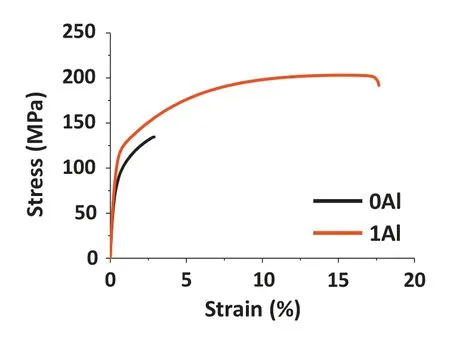
Fig. 2. Tensile engineering stress-strain curves of the Mg-1Al alloy (1Al)and pure Mg (0Al).
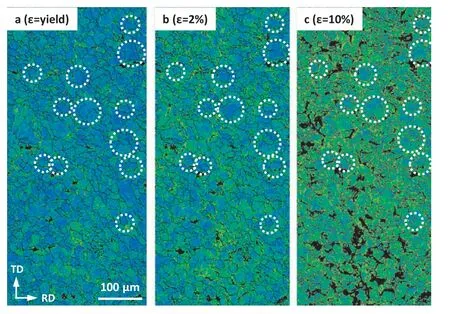
Fig. 3. KAM maps of the Mg-1Al alloy after tensile straining to (a) 0.2%(yielding), (b) 2%, and (c) 10%. The areas showing small changes in KAM values during tensile straining are marked by broken white circles.
Tensile engineering stress-strain curves of the Mg-1Al alloy and pure Mg are shown in Fig. 2. The Mg-1Al alloy has higher strength (yield strength of 112MPa and ultimate tensile strength of 203MPa) and larger elongation (17%) than those (yield strength of 85MPa, ultimate tensile strength of 135MPa, and elongation of 3%) of the pure Mg with similar grain size and texture[21].Considering that the Mg-1Al alloy has similar texture and grain size to those of the pure Mg,the present result suggests that the addition of 1Al improves ductility by activation of other deformation systems that are not usually activated in the pure Mg.
3.2. Change in the local misorientation during tensile deformation
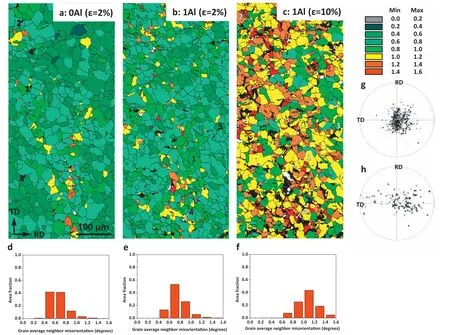
Fig. 4. GAM maps (a, b, c) and GAM profile (d, e, f) of (a, d) the pure Mg after 2% strain, (b, e) the Mg-1Al alloy after 2% strain, and (c, f) the Mg-1Al alloy after 10% strain. (0002) pole figure of the grains having GAM values larger than 0.4° in (g) the pure Mg after 2% strain and (h) the Mg-1Al after 2%strain.
To understand how individual grains with different orientations react to tensile deformation in the Mg-1Al alloy, KAM values at various strain levels were calculated. As seen in Fig. 3a-c showing the variations in the distributions of KAM values within grains with increasing strain from yielding to 10%, the deformation is inhomogeneous at an early stage of deformation(Fig.3a),which persists at higher strains(Fig.3b and c). It can be seen that the grains showing low KAM values at yielding (for example, marked by broken white circles in Fig. 3a) show only a slight increase in KAM values with increasing strain, indicating that these grains did not experience any considerable amount of deformation during tensile straining. To understand why different grains behave differently when subjected to tensile straining, it is needed to separate the grains depending on the degree of deformation they received. Since it is rather cumbersome to separate the grains based on the KAM values giving the misorientation calculated between a certain point and its neighboring perimeters, GAM values giving the misorientation calculated between each neighboring pair of points within the grain were used instead to separate the grains having different degrees of deformation they received during tensile staining (Fig. 4).Here, to compare with the pure Mg having small elongation of 3%, GAM values of the Mg-1Al alloy and pure Mg were calculated for the specimens deformed to 2% strain and the respective grains are marked with different colors to highlight them based on their GAM values ranging from 0.2° to 1.6°as shown in Fig. 4a and b. In addition, GAM values were also calculated for the Mg-1Al alloy deformed to 10% strain(Fig. 4c). In Fig. 4d, it can be seen that in the case of the pure Mg, there is the largest fraction of grains showing GAM values between 0.4° and 0.6° (43%) as well as between 0.6°and 0.8° (43%), followed by 0.8° and 1.0° (12%) and 1.0°and 1.2° (3%). On the other hand, the largest fraction (53%)is found in the grains of the Mg-1Al alloy (Fig. 4e) having the GAM values between 0.6° and 0.8°, which are larger than that of the pure Mg having the same GAM values.In addition,the total fraction of the grains showing GAM values larger than 0.6° is substantially larger in the Mg-1Al alloy than that in the pure Mg (87% vs. 57%), indicating that the grains in the Mg-1Al alloy experience a larger amount of deformation than those in the pure Mg at the same overall tensile strain of 2% despite their similar texture and grain size. With increasing tensile strain to 10% from 2% (Fig. 4f), there is an increase in the overall GAM values and the largest fraction is found in the grains of the Mg-1Al alloy having the GAM values between 1.0° and 1.2°. The basal pole distributions of the grains having GAM values larger than 0.4° when subjected to 2% tensile strain are shown in Fig. 4g and h. In the case of the pure Mg (Fig. 4g), the grains showing the GAM values ranging from 0.4° to 1.2° have their basal poles mostly oriented along the ND as well as tilted towards the RD from the ND. On the other hand, in the case of the Mg-1Al alloy(Fig. 4h), besides the ones mentioned above, the grains having the basal poles tilted towards the TD from the ND also show the GAM values ranging from 0.4° to 1.2°, although the presence of such texture components is not that obvious in the macro-texture shown in Fig. 1c.
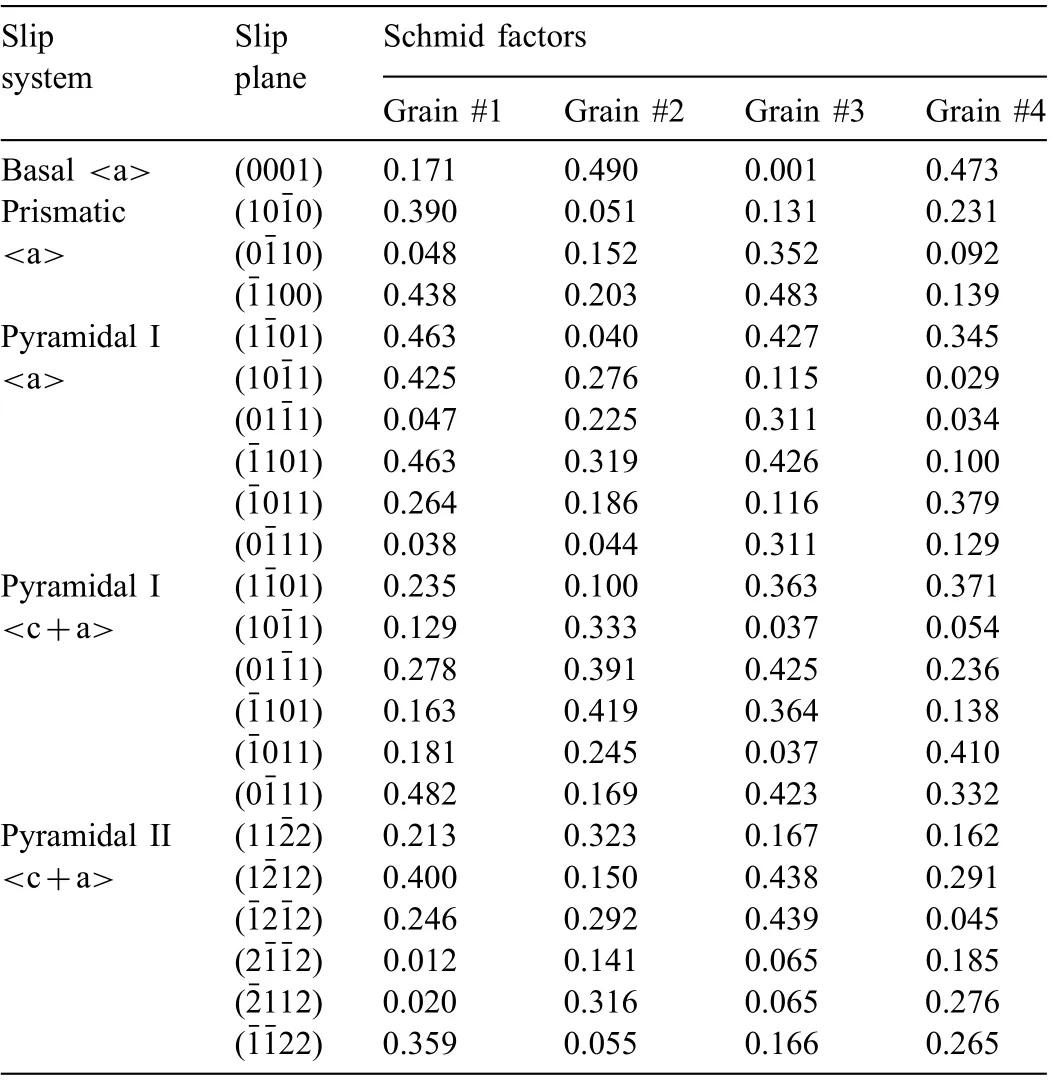
Table 1 Calculated Schmid factors of the slip systems in the grains #1 - 4 of the Mg-1Al alloy.
3.3. Slip trace analyses
Slip trace analyses by in-situ tensile EBSD study along with SEM were conducted for identifying the deformation systems operating within the grains having the representative texture components of the Mg-1Al alloy and the pure Mg; 1)basal poles oriented towards the ND, 2) basal poles oriented towards the RD from the ND, 3) basal poles oriented towards the TD from the ND, and 4) basal poles oriented towards the RD and TD from the ND. The Schmid factors (SFs) of the main slip systems, basal slip, prismatic slip, pyramidal I <a>and <c+a>slips, and pyramidal II <c+a>slip, in the Mg-1Al alloy are calculated and shown in Table 1.
3.3.1. The grains having the basal poles oriented towards the ND
Fig. 5 shows the deformation behavior of the grain #1 in the Mg-1Al alloy (Figs. 1a and 4b, c) having the basal pole oriented toward the ND. In fact, this grain is composed of 2 subgrains tilted by 2° to each other (Fig. 5a). Upon yielding(Fig. 5b), there is a development of slip line (marked by red arrows) in both subgrains. Slip trace analysis shows that the slip line lies along (-1101) plane. There are 3 possible deformation systems acting on (-1101) plane, i.e., pyramidal I<a>slip, pyramidal I <c+a>slip, and compression twin.Calculation of SFs for these deformation systems (Table 1)shows that their maximum SF values are 0.463, 0.163, and 0.043 for the pyramidal I <a>slip,pyramidal I <c+a>slip,and compression twin (not shown in Table 1), respectively,indicating that the observed deformation system is (-1101)[-1-120] pyramidal I <a>slip. This is also confirme by IGMA analyses of the specimens subjected to yielding and 2% strain showing that their IGMA lie along [0-112] as shown in Fig. 5e and f, respectively, which is the characteristic of pyramidal I <a>slip [27]. It is interesting to note that the slip line becomes a bit thicker forming surface step with increasing tensile strain, without the formation of other slip lines being observed (Fig. 5c).

Fig. 5. Slip trace analysis for the grain (#1) of the Mg-1Al having the basal pole oriented towards the ND. (a) before tensile deformation, (b) after yielding, (c) after 10% strain, (d) slip traces for the possible slip systems, (e)IGMA distributions after yielding, and (f) IGMA distributions at 10% strain.Inset:a hexagonal prism showing the crystallographic orientation of the grain.

Fig. 6. Slip trace analysis for the grain (#1′) of the pure Mg having the basal pole oriented towards the ND. (a) After yielding, (b) after 2% strain, (c) slip traces for the possible slip systems, and (d) IGMA distributions after 2%strain. Inset: a hexagonal prism showing the crystallographic orientation of the grain.
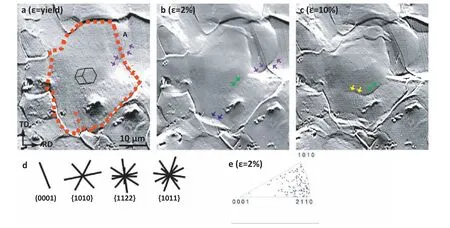
Fig. 7. Slip trace analysis for the grain (#2) of the Mg-1Al having the basal pole oriented towards the RD from the ND. (a) After yielding, (b) after 2%strain, (c) after 10% strain, (d) slip traces for the possible slip systems, and (e) IGMA distributions after 2% strain. Inset: a hexagonal prism showing the crystallographic orientation of the grain.
The results of slip trace analyses of the grain #1′in the pure Mg (Figs. 1b and 4a) having the similar orientation to the grain #1 in the Mg-1Al alloy are shown in Fig. 6. Upon yielding, there is a formation of curved (marked by yellow arrows) and straight (marked by red arrows) lines. In fact,the curved line (marked by yellow arrows) appears to be the result of buckling of the grain, which becomes more obvious with increasing the strain to 2% (Fig. 6b). Considering that the curved line (marked by yellow arrows) does not match with any of possible slip traces (Fig. 6c) and the buckling also occur in the region A in the neighboring grain, it can be said that the bucking is the result of large amount of deformation in the grain B, which is well oriented for basal slip (SF of 0.48) and whose grain boundary might be located underneath the observed surface. On the other hand, the straight line (marked by red arrows) matches with the trace of (-12-12) pyramidal II slip having of SF of 0.416. IGMA analysis of the specimen subjected to 2% strain shows that its IGMA lies along [uvw0] as shown in Fig. 6d, which is the characteristic of pyramidal II slip [27].
3.3.2. The grains having the basal poles oriented towards the RD from the ND
In the case of the grain #2 in the Mg-1Al alloy having the basal pole oriented towards the RD from the ND, two types of slip lines are observed upon yielding (Fig. 7a); basal slip lines marked by red arrows (SF of 0.490) and another line(marked by purple arrows), which appears to be also present in a neighboring grain across the grain boundary. In fact, the region A in the neighboring grain is the tension twin formed upon yielding. With increasing strain (Fig. 7b), there is a formation of another tension twin (marked by blue arrows)in the grain #2 and the tension twin A formed in the neighboring grain grows in size with forming surface step across the grain boundary, indicating that the purple line is actually a tension twin boundary that protrudes from the tension twin formed underneath. In addition, there is a formation of new slip line (marked by green arrows) with increasing strain.Due to its curved shape, it is not possible to unambiguously identify its nature, but the slip line closely matches with(11-22) pyramidal II slip trace and (0-111) pyramidal I slip trace. Considering the SFs of these possible slips (0.323 for the pyramidal II, 0.044 for the pyramidal I <a>, and 0.169 for the pyramidal I <c+a>slips), it can be thought that the green slip line is due to the operation of (11-22)[-1-123]pyramidal II slip. An activation of pyramidal II slip, not pyramidal I slip, can also be confirme by IGMA analysis of the specimen subjected to 2% strain showing that its IGMA lies along [uvw0] as shown in Fig. 7e. As is the case of the grain#1 in the Mg-1Al alloy, the pyramidal II slip line becomes thicker forming surface step with increasing tensile strain(Fig.7c).It can also be seen that the slip line extends forming a curved line (marked by yellow arrows), whose trace is close to another variant of pyramidal II slip having a SF of 0.316.
Fig. 8 shows the deformation behavior of the grain #2′in the pure Mg having the similar orientation to the grain #2 in the Mg-1Al alloy. It can be seen that there is an activation of basal slip (marked by red arrows) having a SF of 0.482 as well as tension twinning (marked by blue arrows) upon yielding (Fig. 8a). With increasing the strain to 2% (Fig. 8b),there is virtually no change in deformation behavior except the formation of a slip-like line (marked by green arrows).However, this line does not match with any of the possible slip systems and appears to be a result of buckling of the grain due to deformation in the surrounding grains. An absence of non-basal slip lines in this grain of the pure Mg is different from the above-mentioned result of the Mg-1Al alloy showing an activation of pyramidal slip.
3.3.3. The grains having the basal poles oriented towards the TD from the ND
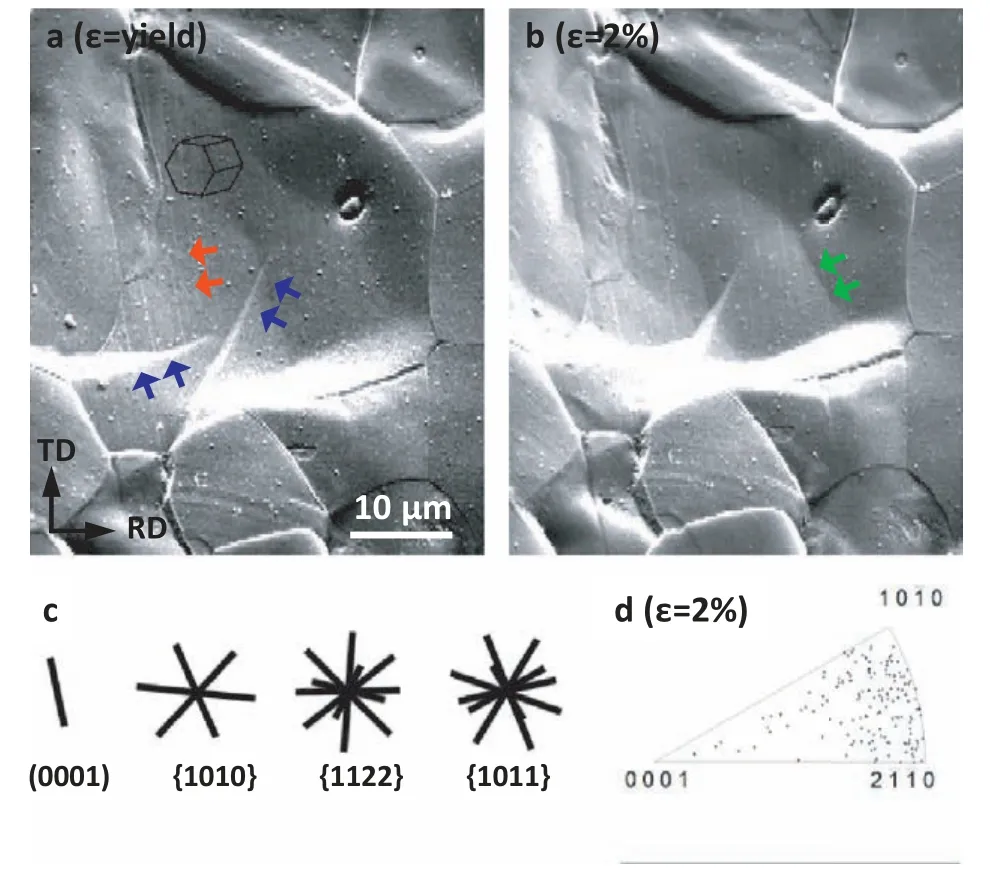
Fig. 8. Slip trace analysis for the grain (#2′) of the pure Mg having the basal pole oriented towards the RD from the ND. (a) after yielding, (b) after 2%strain, (c) slip traces for the possible slip systems, and (d) IGMA distributions after 2% strain. Inset: a hexagonal prism showing the crystallographic orientation of the grain.
For the grain #3 in the Mg-1Al alloy having the basal pole oriented towards the TD from the ND (Fig. 9), such orientation gives very low SF of 0.01 for basal slip. There is no visible slip line formed until straining to 2%, at which the slip line (marked by red arrows) appears inclined ~80° with respect to the loading direction (Fig. 9b). Slip trace analysis shows that the slip line is close to that of (1-212) pyramidal II slip (Fig. 9d), but the possibility of it being from (-1100)prismatic slip cannot be excluded. SFs for these two slip systems are almost same (0.438 for the pyramidal II slip and 0.483 for the prismatic slip), which again makes the identifi cation of the slip system ambiguous.However,IGMA analysis(Fig. 9e) shows that the IGMA lies along [10-10], indicating that pyramidal II slip operates in the grain #3. Upon further tensile straining, there is no noticeable operation of other slip systems, while the pyramidal II slip line becomes thicker forming surface step similar to the cases of the non-basal slips formed in the grains #1 and #2 in the Mg-1Al alloy.
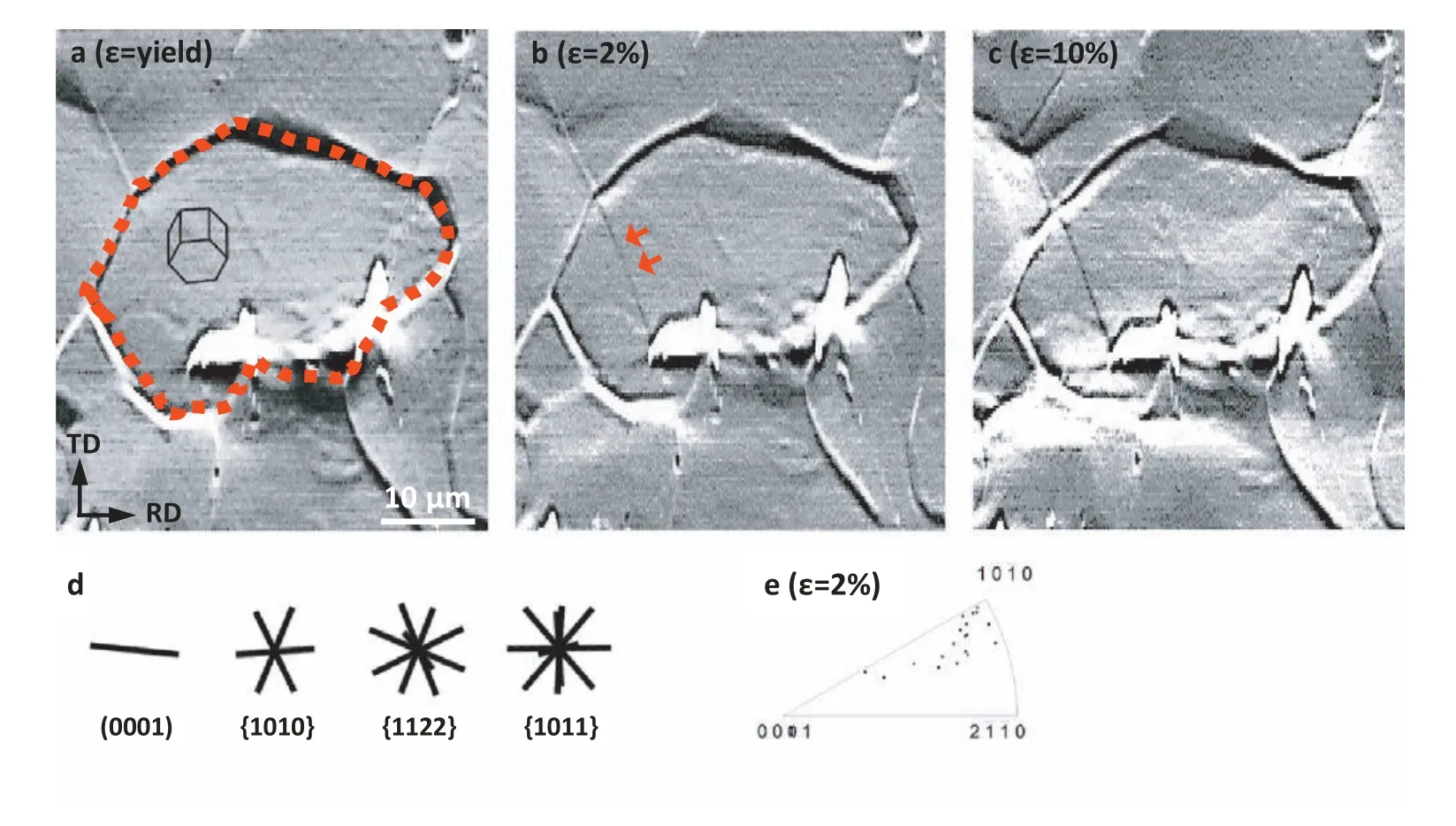
Fig. 9. Slip trace analysis for the grain (#3) of the Mg-1Al having the basal pole oriented towards the TD from the ND. (a) after yielding, (b) after 2%strain, (c) after 10% strain, (d) slip traces for the possible slip systems, and (e) IGMA distributions after 2% strain. Inset: a hexagonal prism showing the crystallographic orientation of the grain.
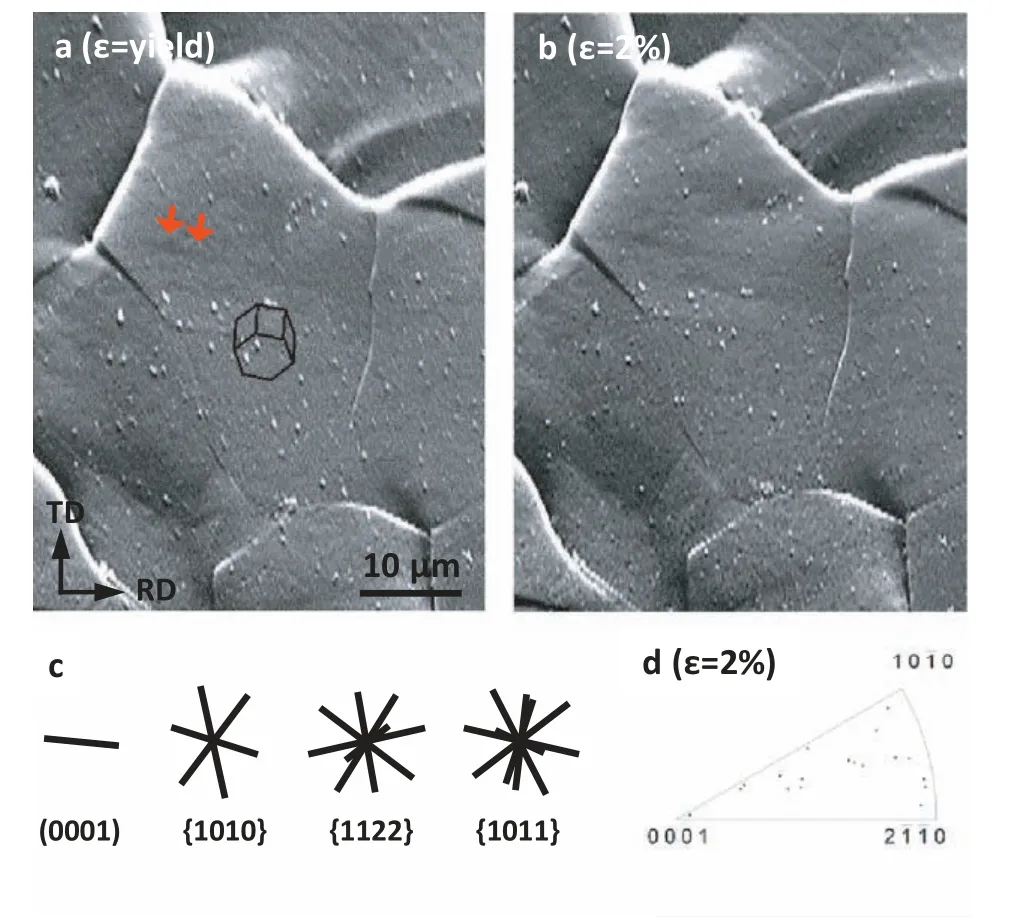
Fig. 10. Slip trace analysis for the grain (#3′) of the pure Mg having the basal pole oriented towards the TD from the ND. (a) After yielding, (b) after 2% strain, (c) slip traces for the possible slip systems, and (d) IGMA distributions after 2%strain.Inset:a hexagonal prism showing the crystallographic orientation of the grain.
In the case of the grain #3′in the pure Mg having the similar orientation to the grain#3 in the Mg-1Al alloy,there is also no clear slip line formed until straining to 2%, except the diffuse slip-like lines (marked by red arrows) that are inclined~11° with respect to the loading direction (Fig. 10a and b).Although these lines closely match with (-1101) pyramidal I slip trace(Fig.10c),its SF is very low(0.158)and IGMA also shows no evidence for its formation (Fig. 10d), suggesting that there is virtually no deformation occurring in this grain#3′in the pure Mg having the basal pole oriented towards the TD from the ND, unlike the case of the grain #3 in the Mg-1Al alloy showing an activation of pyramidal II slip.
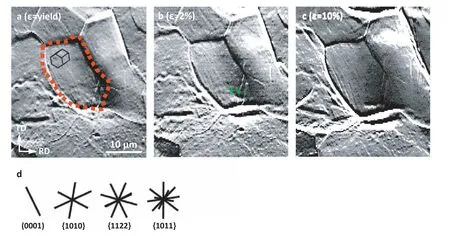
Fig. 11. Slip trace analysis for the grain (#4) of the Mg-1Al having the basal pole oriented towards the RD and TD from the ND. (a) After yielding, (b) after 2% strain, (c) after 10% strain, and (d) slip traces for the possible slip systems. Inset: a hexagonal prism showing the crystallographic orientation of the grain.
3.3.4. The grains having the basal poles oriented towards the RD and TD from the ND
Fig. 11 shows an example of the grain (#4) having the basal pole oriented towards the RD and TD from the ND.It can be seen that upon yielding, there is a development of slip lines that are inclined ~62° with respect to the tensile loading direction (Fig. 11a). Slip trace analysis shows that deformation occurs by(0001)[-1-120]basal slip having a SF of 0.473. Besides the formation of tension twin at 2% strain(marked by green arrows in Fig. 8b), there is no activation of other deformation systems with increasing strain (Fig. 11c).
The results of slip trace analyses of the grain #4′in the pure Mg having the similar orientation to the grain #4 in the Mg-1Al alloy are shown in Fig. 12. It can be seen that there is an activation of (0001)[-1-120] basal slip (marked by red arrows) having a SF of 0.479 as well as the formation of tension twin (marked by blue arrows) upon yielding (Fig. 12a),which persist until straining to 2% without an activation of other deformation systems (Fig. 12b). Such behavior is quite similar to that of the Mg-1Al alloy having the similar orientation (Fig. 11).
4. Discussion
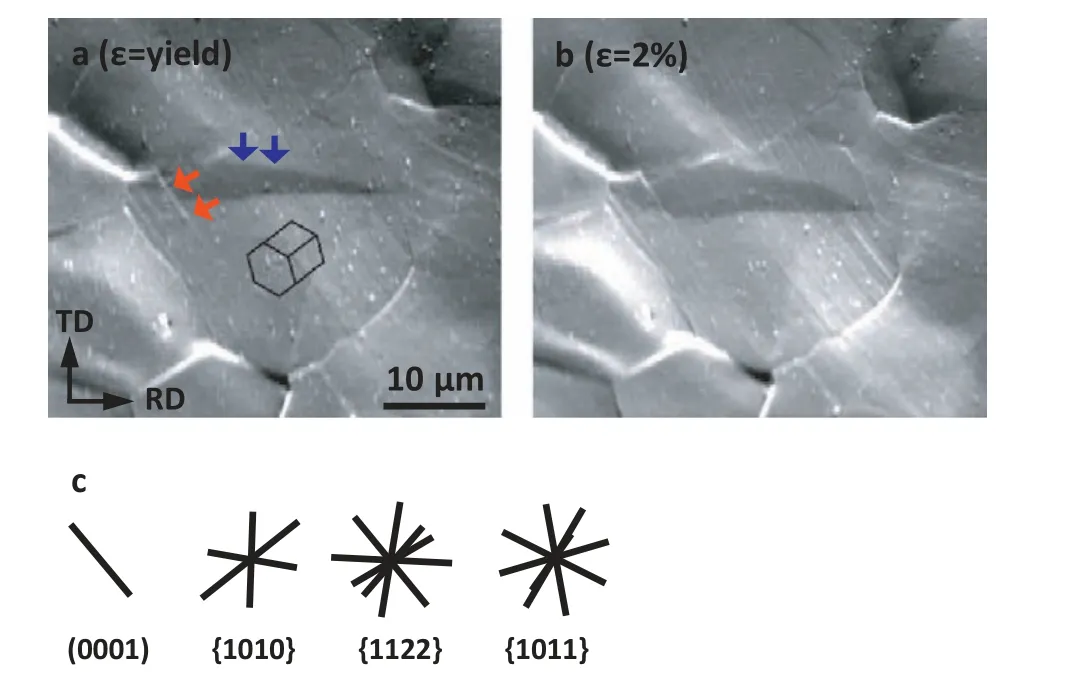
Fig. 12. Slip trace analysis for the grain (#4′) of the pure Mg having the basal pole oriented towards the RD and TD from the ND. (a) After yielding,(b) after 2% strain, and (c) slip traces for the possible slip systems. Inset: a hexagonal prism showing the crystallographic orientation of the grain.
As seen in Fig. 4a and b, the Mg-1Al alloy shows a larger degree of deformation within grains (higher GAM values)than the pure Mg at the same amount of tensile strain (2%strain), although they have similar texture and grain size. The ability of the Mg-1Al alloy to accommodate more deformation than the pure Mg can be considered mainly due to an activation of non-basal slips, which are reported to be rarely observed in the pure Mg [14,28,29]. Several simulation studies reported that an addition of Al increases the CRSS for basal slip more than those of non-basal slips so that there would be a decrease in the ratio of non-basal to basal CRSS[20,21,23,30], leading to an easier activation of non-basal slips in the Mg-1Al alloy than in the pure Mg. In fact, slip trace analyses of the Mg-1Al alloy confirme an activation of non-basal slips as shown in Figs. 5,7, and 9. Interestingly,slip trace analyses of the pure Mg also show an activation of non-basal slip(pyramidal II slip),but only in the grain having the basal pole oriented towards the ND (Fig. 6). This might be for the case when the RSS becomes larger than the CRSS for the pyramidal II slip in the pure Mg. Otherwise, an activation of non-basal slips are not observed in other grains having different orientations in the pure Mg. For example, when the grains are favorably oriented for basal slip, i.e., when thebasal poles are oriented towards the RD from the ND (Fig. 8)and towards the RD and TD from the ND (Fig. 12), the slip system operating in the pure Mg is basal slip, similar to the cases of the Mg-1Al alloy (Figs. 7 and 11). However, while the Mg-1Al alloy shows an activation of non-basal slip in addition to basal slip in the grain having the basal pole oriented towards the RD from the ND (Fig. 7), the pure Mg does not show an activation of other slip systems besides basal slip(Fig. 8), although they have the similar orientation. In the case of the grain having the basal pole oriented towards the TD from the ND, there is virtually no slip systems activated in the pure Mg (Fig. 10), while an activation of pyramidal II slip is observed in the Mg-1Al alloy (Fig. 9). These results indicate that an activation of non-basal slips is promoted by an addition of 1Al.
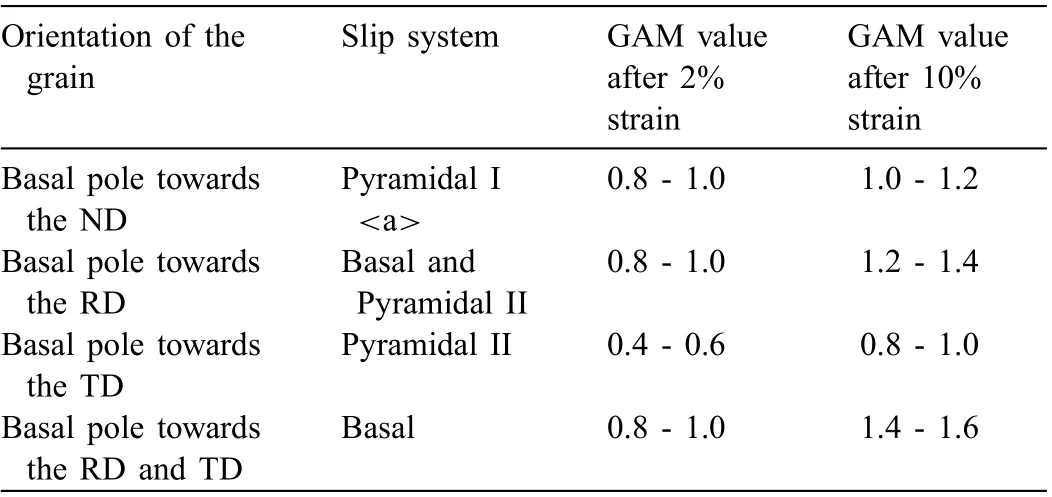
Table 2 Operating slip systems and GAM values in the Mg-1Al alloy depending on the orientation of grains.
Nevertheless, it is observed that the deformation in the Mg-1Al alloy is not homogeneous among grains such that some grains show a larger GAM values than the others. For example, the grains #1 and #3 show the small GAM values ranging from 0.8° to 1.2° after 10% strain, while the grains#2 and #4 show the large GAM values ranging from 1.2° to 1.6° after 10% strain. The major difference in these grains having different GAM values is in the dominant deformation systems operating in the grains,whose results are summarized in Table 2. In the case of the grains #1 and #3 showing small GAM values, the major deformation system is either pyramidal I <a>slip (grain #1) or pyramidal II <c+a>slip (grain #3). On the other hand, in the cases of the grains#2 and #4, there is an activation of basal slip in both grains with an additional activation of pyramidal II slip in the grain#2.
The above results indicate that the grains can accommodate a large amount of deformation only when basal slip operates as a dominant slip system, while an activation of non-basal slips would have a minor contribution to overall deformation of the alloy although they can be easily activated at an early stage of deformation by an addition of 1Al to Mg.When nonbasal slips operate in grains of the Mg-1Al alloy, it is shown that the deformation is not homogeneous within grains and strain is localized forming surface steps on an initially formed slip lines rather than forming multiple slip lines. Such strain localization usually occurs when the slip plane becomes soft by the movement of dislocations [31] so that further nucleation and propagation of dislocations would be concentrated preferentially along such plane. Such strain localization has not been reported in Y and/or other rare earth (RE) elements containing Mg alloys, whose large ductility is ascribed to an active formation of pyramidal I and II <c+a>dislocation slips along with <c+a>cross slips [13,32]. It has also been suggested that an addition of the solutes such Y and RE considerably decreases the operative cross slip energy barrier,enabling fast dislocation multiplication through double cross slips, while an addition of Al does not decrease the cross slip energy barrier to the level below which cross slip can easily occur [24,32]. Hence the occurrence of strain localization in the present Mg-1Al alloy would be due to an inability of non-basal slips to cross slip. Such strain localization occurred in the present alloy might explain the differences in the reported tensile properties between the Mg-1Al alloy subjected to the present study as well as the one studied by Shi et al. [22] and the Mg-1Al-0.1Ca alloy [25], all having a similar basal texture. The present Mg-1Al alloy having an average grain size of 14.5 μm shows somewhat lower UTS(203MPa) and smaller elongation (17%) than the one studied by Shi et al. having a grain size of 10-14 μm showing UTS of 230MPa and elongation of about 20% [22], which are in fact quite similar to those(UTS of 220MPa and elongation of about 20%) of the Mg-1Al-0.1Ca alloy having a coarse grain size of 35-50 μm [25]. However, an increase in grain size of the Mg-1Al alloy to 34-42 μm resulted in decreases in UTS (~200MPa) and elongation (~11%), which are worse than those, particularly elongation, of the Mg-1Al-0.1Ca alloy having a similar grain size (35-50 μm). There are several factors that can affect ductility of Mg alloys such as texture,grain size, solute contents, etc. Considering the similarities in the texture and grain size of the Mg-1Al-0.1Ca alloy and the coarse grained Mg-1Al alloy, it can be thought that the larger elongation of the Mg-1Al-0.1Ca alloy than that of the coarse grained Mg-1Al alloy is due to the effect of solute (0.1Ca) on modifying the deformation behavior of Mg-1Al alloy. While both alloys show an enhanced activation of non-basal slips,the non-basal slips activated in the Mg-1Al alloy are mostly localized on a few slip planes limiting its ductility below that of the Mg-1Al-0.1Ca alloy.
5. Conclusions
In the present study, the effect of 1Al addition on the deformation behavior of Mg has been investigated. Deformation systems operating within the grains of the alloy were identifie by slip trace analyses using in-situ tensile EBSD along with SEM.
1. The Mg-1Al alloy has higher strength and larger elongation than the pure Mg having similar grain size and texture.
2. At the same amount of applied tensile strain, the grains in the Mg-1Al alloy are seen to accommodate a larger degree of deformation than the ones in the pure Mg, irrespective of the orientations of the grains.
3. Examination of deformation microstructure by slip trace analysis along with IGMA analysis shows that various types of non-basal slips such as pyramidal I and II slips are easily activated in the Mg-1Al alloy at an early stage of deformation.
4. With increasing tensile strain, there is a strain localization along the initially formed slip lines of non-basal slips,forming surface steps without activating multiple slip lines,which might be responsible for somewhat lower ductility of the Mg-1Al alloy as compared to the Mg-1Al-0.1Ca alloy.
Declaration of Competing Interest
The authors declare that they have no known competing financia interests or personal relationships that could have appeared to influenc the work reported in this paper.
Acknowledgment
This work was financiall supported by the POSCO, Korea.
杂志排行
Journal of Magnesium and Alloys的其它文章
- Mechanism of Mn on inhibiting Fe-caused magnesium corrosion
- An efficien and comparative adsorption of Congo red and Trypan blue dyes on MgO nanoparticles: Kinetics, thermodynamics and isotherm studies
- Twin recrystallization mechanisms in a high strain rate compressed Mg-Zn alloy
- Corrosion behaviour and cytocompatibility of selected binary magnesium-rare earth alloys
- Correlation between test temperature, applied load and wear transition of Mg97Zn1Y2 alloy
- Residual stress and precipitation of Mg-5Zn-3.5Sn-1Mn-0.5Ca-0.5Cu alloy with different quenching rates
